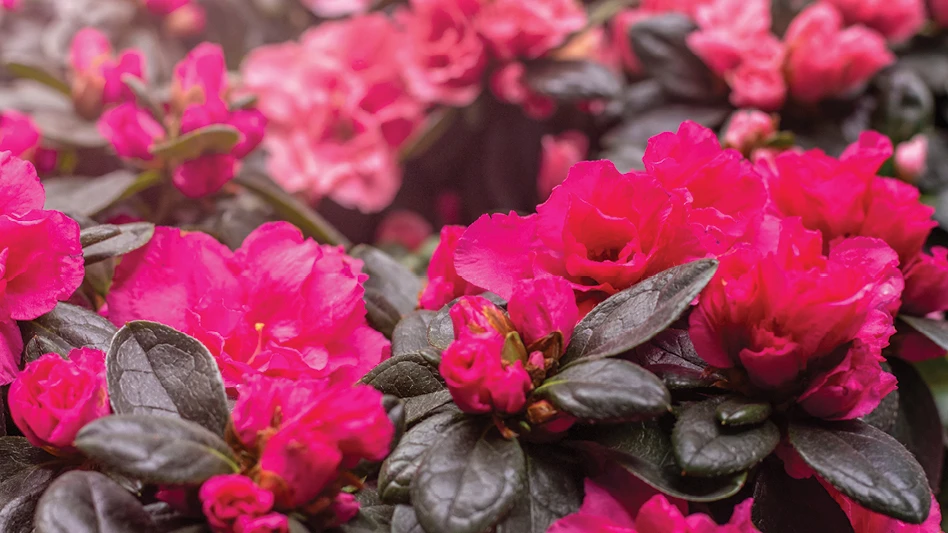

Caterpillars are the immature larval stage of moths and butterflies in the order Lepidoptera. Most overwinter outdoors and may migrate into greenhouses during the summer and fall. Night flying moths may be attracted to lights near greenhouses and female moths enter the greenhouse to lay their eggs on susceptible crops. The caterpillars you will encounter will depend upon your location and the crops you grow.
Some of the caterpillars growers may encounter include diamondback moth (Plutella xylostella), cabbage looper (Trichoplusia ni), imported cabbageworms (Artogeia rapae), beet armyworm (Spodoptera exigua), tobacco budworm (Helicoverpa virescens), European corn borer (Ostrinia nubilalis), corn earworm (Helicoverpa zea), leafrollers (Choristoneura spp.), salt marsh caterpillar (Estigmene acrea) and various types of cutworms.
Feeding damage
Caterpillars use their chewing mouthparts to feed on plant leaves and flowers. Adults feed on pollen and nectar. Some caterpillars roll plant leaves together in a silken web (leafrollers), others tunnel into stems and buds (borers), and some are active at night cutting off plants at their base (cutworms). Caterpillars are voracious feeders and can severely damage plants. They leave fecal droppings or insect frass on the damaged plant leaves.

Different species of caterpillars have different host ranges among a wide variety of plants. For example, imported cabbageworms, cabbage looper and diamondback moth feed on Cole crops, including ornamental cabbage and kale. European corn borer may feed on Chrysanthemum, Dahlia, Heliopsis and Leucanthemum, especially if these plants are grown near cornfields.
Scouting for caterpillars
Visually inspect ornamental plants when moth or butterfly adults are active. In greenhouses, pay close attention to susceptible plants near doors, vents and other openings, especially near vegetable fields. Caterpillars are voracious feeders and can severely damage plant. Look for signs of feeding damage and caterpillar frass or droppings. Caterpillars have five or fewer prolegs on their abdomen with hooks known as “crochets” at the tip of these prolegs. If unsure, always send samples to an extension entomologist for identification.

Biological controls
The commercially available egg parasitoid, Trichogramma spp. lay their eggs into the eggs of some caterpillar pests such as the diamondback moth, cabbage looper and imported cabbageworm. Timing is critical, as these very small wasps only work against the egg stage and not the damaging larvae. When releasing these mini-wasps, protect them from ants.
Chemical controls
There are a number of contact insecticides, including microbial insecticides, that can be used against caterpillars. Contact insecticides are directed against the larvae stage, and thorough coverage is needed. Bacillus thuringiensis spp. kurstaki, (MOA 11A) (BTK) (Dipel DF, Deliver, Javelin, Thuricide N/G) is most effective against the young, feeding larvae. The caterpillars must consume this bacterium for it to be effective, so thorough spray coverage is needed. Repeat applications because BTK is susceptible to breakdown from ultraviolet light and may be washed off the leaves. When spraying plants with waxy leaves, such as ornamental kale and cabbage, add a spreader sticker (as long as the label permits). After eating BTK, caterpillars usually die after three to four days. Conserve (spinosad) (MOA 5) works as a contact and stomach poison against caterpillars. Pyrethroids (MOA 3A) are also labeled for caterpillars but they are more harmful to many natural enemies.
Get curated news on YOUR industry.
Enter your email to receive our newsletters.

Explore the July 2020 Issue
Check out more from this issue and find your next story to read.
Latest from Greenhouse Management
- Growing enlightened
- American Floral Endowment awards 17 organizations $60,700 in educational grants
- Floral businesses invited to join Society of American Florists' Petal It Forward event in October
- Bioline AgroSciences acquires Viridaxis to strengthen leadership in aphids biocontrol
- Ryley Leech joins JumpLights as vice president of sales
- Meet the Retailers' Choice Awards from 2025 Farwest Show
- Added value
- National Garden Bureau announces featured crops for 2026 'Year of the' program





